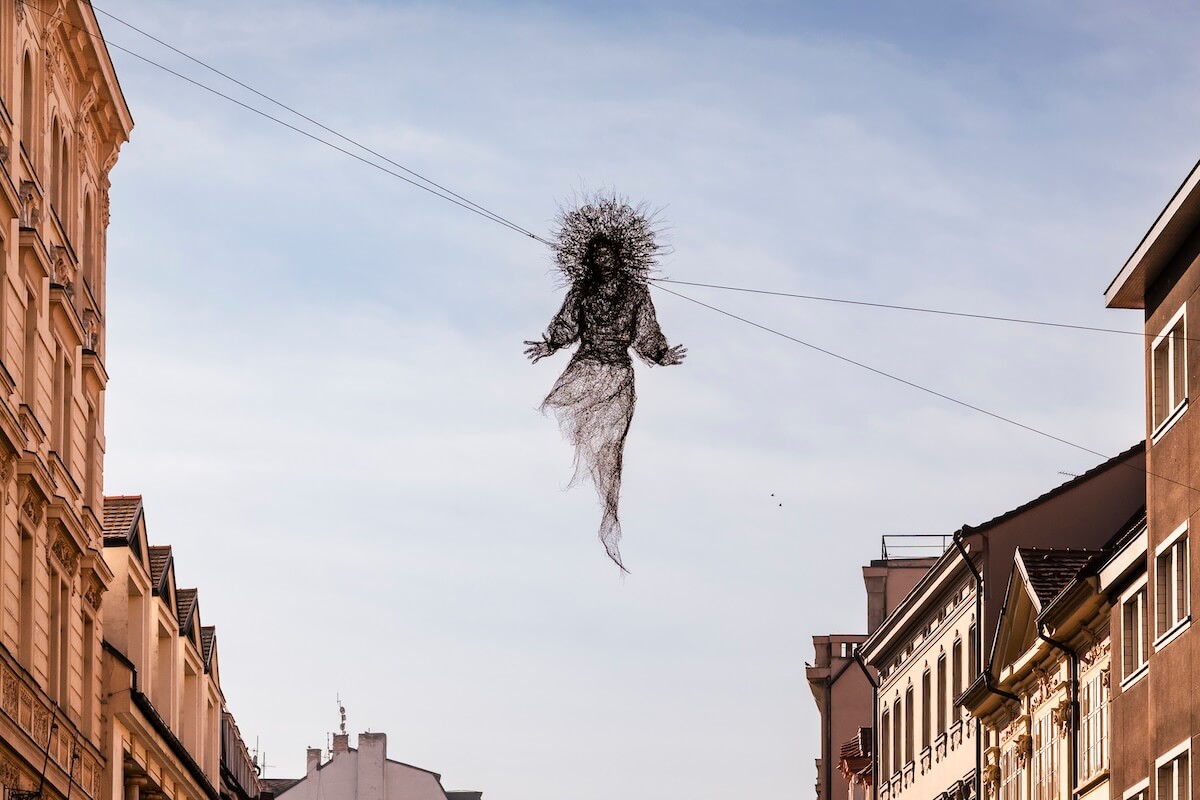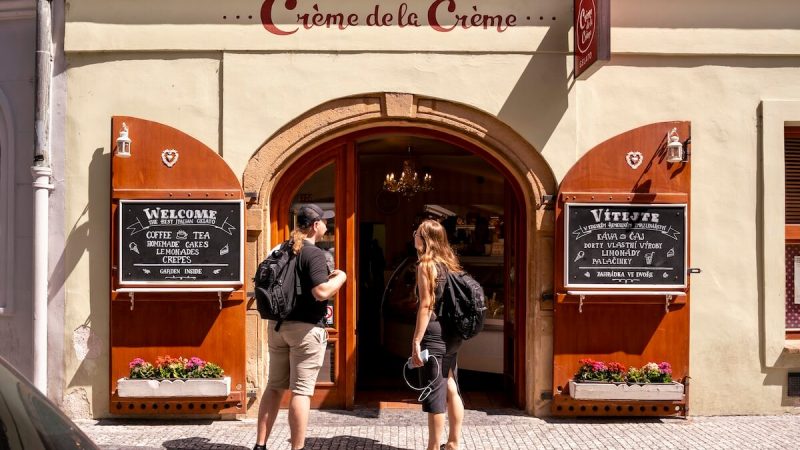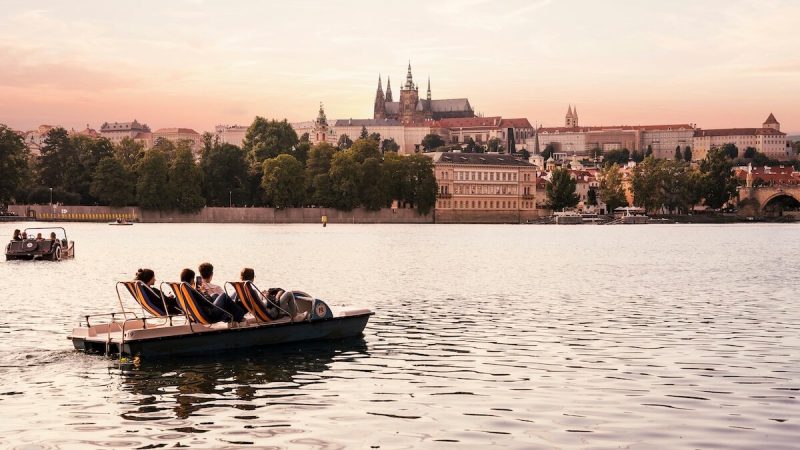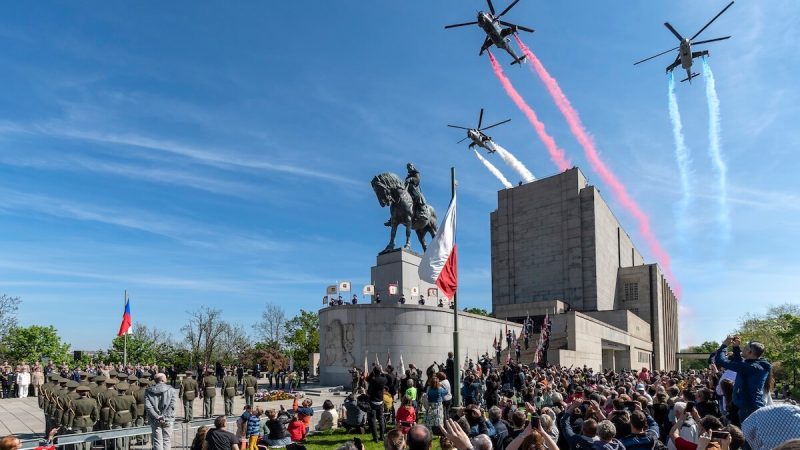6 Mind-Blowing Sculptures Hidden in Prague 2025 + Map

Looking beyond famous medieval landmarks? The city hides an astonishing collection of Prague’s contemporary sculptures that tell dark, deep stories. From floating figures, ghostly creatures to alien embryos, these six unusual art installations introduce Prague as an open-air gallery.
As a local, I’ll take you on a walk to discover these striking works of art. Each piece has a deeper meaning, whether political, historical, or purely imaginative. Get ready to see Prague’s streets in a whole new way!
You’ll find a handy map showing the location of each statue At the end of the article. You can use it to plan a route and enjoy a scenic walk to see them all.
1. The Memorial to the Victims of Communism by Olbram Zoubek
🇨🇿 (Czech name) Pomník obětem komunismu 🗓️ (Year of Installation) 2002 📍(Location) Újezd 420/14, Prague 1 – Lesser Town

At the foot of Petřín Hill, where the shadows of Prague’s past meet its present, stands one of the city’s most haunting contemporary monuments. The Memorial to the Victims of Communism, created by renowned Czech sculptor Olbram Zoubek, transforms human suffering into a powerful artistic statement that stops visitors in their tracks.
Seven bronze figures process down a staircase in what appears, at first glance, to be a simple line of statues. But as you follow their descent through the appropriately named Alley of the Victims of Totalitarianism, they witness a devastating transformation.

The leading figure stands complete, a testament to human dignity. Yet with each subsequent statue, the bodies begin to fragment and decay. Limbs disappear, torsos split apart, and the bronze forms progressively disintegrate – a brutal metaphor for the systematic destruction of human lives under totalitarian rule.
Figures symbolizing citizens – victims. It is a man who is being destroyed by totalitarian power, but still stands and resists.

The memorial’s impact goes beyond its striking visual metaphor. Running through the installation, a bronze strip carries the cold statistics of communist oppression:
- 205,486 people were sentenced
- 248 were executed
- 4,500 died in prisons
- 327 were killed while attempting to escape across borders
- 170,938 forced to flee their homeland
These numbers, etched in metal, transform abstract historical data into a tangible record of human suffering.
2. Vinok by Veronika Psotková
🇨🇿 Vinok 🗓️ 2022 📍Dlouhá 731/33, Prague 1 – Old Town

Vinok is a striking wire sculpture by Czech artist Veronika Psotková suspended above Dlouhá Street outside NoD Gallery. This powerful installation is not just an artwork. It is a symbol of resilience, remembrance, and protest, created in response to the ongoing war in Ukraine.
It takes its name from the traditional Ukrainian flower wreath (вінок) – a symbol whose meaning has evolved from pagan ritual to national identity.
The inspiration struck Veronika during the war’s early days, as she saw images of Ukrainian women wearing these traditional flower crowns. What emerged is a piece that NoD Gallery curator Pavel Kubesa describes as “inherently ambiguous – beautiful and terrifying simultaneously.”

Unlike traditional statues, Vinok is almost ethereal, made from interconnected steel wires that form a delicate yet haunting silhouette. It honors Ukrainian women and mothers suffering under Russian aggression, while serving as the artist’s protest against the ongoing war.
As the tenth installation in NoD’s series addressing current social, political or environmental issues, it stands as a gesture of solidarity with Ukraine. Floating above the street, it compels passersby to pause and reflect.
3. Embryo by David Černý
🇨🇿 Embryo 🗓️ 2008 📍Anenské Square 209/5, Prague 1 – Old Town

An otherworldly figure clings to a drainpipe on the facade of Theatre Na Zábradlí. It is David Černý’s “Embryo,” installed in 2008 for the theatre’s 50th anniversary.
The piece transforms nightly into a glowing apparition that, depending on the viewer’s imagination, might appear as a developing human form or an alien visitor to Prague’s ancient streets.
David Černý’s public installations have a way of evoking strong reactions, there’s rarely any middle ground. You either love them or hate them. But one thing is certain: they always spark emotions.
Embryo is no exception. Even among the actors of Theatre Na Zábradlí, where it is installed, opinions were divided. Some saw it as a symbolic heartbeat of the theatre, a representation of creative birth. Others viewed it as an unsightly blemish, more of a ulcer than an embryo, and called for its immediate removal.

And David Černý response? Of course with his signature irony: “I agree with covering up my work. What I did was highly subversive and a low blow to all those poor, weary souls of the Theatre Na Zábradlí theatre.”
What does Embryo really symbolize? Was the media clash between the actors and the artist genuine? Or was it just a clever attempt to draw attention to the piece? I’ll leave that up to you.
Do you like David Černý’s work? Check my article about his most famous installations in the city center.
4. The House of the Son and The House of the Mother by John Hejduk
🇨🇿 Dům syna a Dům matky 🗓️ created 1980, installed here 2015 📍Alšovo nábřeží 80/10, Prague 1 – Old Town

One of Prague’s most conceptually complex monuments – the House of the Suicide and the House of the Mother of the Suicide, is a work that blurs the boundaries between architecture and sculpture.
These two structures are a tribute to Jan Palach, the student who set himself on fire in January 1969 to protest the Soviet occupation of Czechoslovakia. Author, renowned architect John Hejduk, was deeply touched and inspired by a poem “The Funeral of Jan Palach” written by David Shapiro.

The two structures are only a few feet apart and interact with each other. Each of their element speaking its own language of loss and remembrance.
The House of the Son has no entrance so he can’t share his feelings or share his personal space. It’s crafted in polished stainless steel seemingly glowing into the space with pure light. The crown of thorns spreads outward like open hands, reaching out as if to send its message and energy to the universe.
The Mother’s House has a small entrance where visitors can climb stairs to a narrow window overlooking the Son’s House. Its roof features dull thorns curling skyward in anguish, while its rusting Corten steel surface enhances the sense of grief.
Both structures stand close to the Faculty of Arts, where Jan Palach studied.
5. Il Commendatore by Anna Chromy
🇨🇿 Plášť svědomí 🗓️ 2000 📍Železná 540/11, Prague 1 – Old Town

One of Prague’s creepiest statues is called “Il Commendatore” by artist Anna Chromy. It’s basically a hollow, empty cloak standing outside the Estates Theatre. What makes it cool is there’s nobody inside the cloak – it’s just empty space!
This statue is linked to Mozart’s famous opera “Don Giovanni,” which first played at this exact theater way back in 1787. The character Il Commendatore is like a ghost who comes back for revenge in the story.

Made of bronze, the statue gives off weird vibes. When you look under the hood, you find nothing there – just emptiness. This makes it extra spooky! The flowing robes make it look like someone invisible might be wearing them.
The emptiness is what makes it so powerful. Another name is “Cloak of Conscience,” but it has earned several nicknames among locals, including “Pieta,” “Grim Reaper”, or “Nazgûl,” after those scary ghost riders from “The Lord of the Rings.”
Update (November 2025): The statue Il Commendatore was removed from its spot in front of the Estates Theatre. Prague 1 acted on a long term request from the National Theatre, which argued that the sculpture did not artistically fit the historic architecture of the building.
Its placement had been controversial from the very beginning. Art critics, former directors of the National Gallery, and even teachers and students of the Academy of Fine Arts repeatedly argued that the sculpture was kitschy, artistically weak, and out of place in a historic location.
6. Slight Uncertainty by Michal Trpák
🇨🇿 Lehká nejistota 🗓️ 2015 📍Lady: Na Zbořenci 263/9, Man: Odborů 263/2, Prague 1 – New Town

Have you seen those floating people in Prague? They’re part of Michal Trpák‘s art called “Slight Uncertainty.” These are human-looking figures hanging in the air, each holding an umbrella.
Made from fiberglass and resin, they look like they’re floating above the streets, which feels like something from a dream or a bit weird – in a good way!

The art makes you think about how life can be uncertain and unpredictable. The figures are wearing business clothes, like office workers, showing how we all try to deal with today’s world – always moving but never really feeling settled. The umbrellas seem to both help them and show how vulnerable they are.
The author says: “The feeling from lightness of the flight but also uncertainty from the duration of the flight and landing. While some are still hovering, the others are already waiting for landing.”
When you walk by and look up, it makes you stop and think about your own live. Are we really in charge of where we’re going, or are we just floating along? This art is a playful but meaningful reminder that life is a delicate balancing act.
You’ll find them above a quiet street in front of Mosaic House building. This area is full of Trpák’s artwork! The surroundings are decorated with more of his creations, like the giant illuminated mushrooms called “Looking for Happiness” on Mosaic House’s balconies, and a giant fly named “What is Happiness” attached under the attic of the opposite house.

Map of Contemporary Sculptures in Prague 2025
As you wander Prague’s ancient streets, take a moment to look up, peek around corners, and venture beyond the usual tourist paths. You might find something unexpected as Prague is dotted with impressive works of art.
Have you discovered other unusual statues during your Prague explorations? Should I make a Part II and introduce more of Prague’s contemporary art installation in public space? Let me know in the comments.
Useful Travel Resources
I want to share and recommend these travel resources that I personally use, as they can be helpful when planning your visit to Prague.
Accommodation: Booking.com has the largest selection of incredible places to stay.
Tours: Getyourguide.com has the widest selection of guided tours and experiences from various providers, conveniently sortable by rating.
Getting around: PID Lítačka mobile app lets you buy public transportation tickets and plan your journey easily.
Last article update: November 26, 2025
Author and photo: Vera Nemochovska




